Eating behavior and methods of complementary feeding introduction: A randomized clinical trial in Brazilian children
IF 2.5
3区 医学
Q2 BEHAVIORAL SCIENCES
引用次数: 0
Abstract
Background
A child's early eating experiences, such as the introduction of complementary foods (CF), are critical points for the development of their eating behavior.
Objective
This study aims to analyze the impact of different CF approaches on the eating behavior of children.
Methods
A randomized clinical trial was conducted with mother-infant pairs, followed from 5.5 months to 12 months of age. The sample was randomized into three distinct CF methods: Parent-Led Weaning (PLW), Baby-Led Introduction to Solids (BLISS), or a mixed approach combining both methods. The Child Eating Behavior Questionnaire (CEBQ) was administered online at 12 months, assessing scales such as ‘food responsiveness’, ‘emotional overeating’, ‘enjoyment of food’, ‘desire to drink’, ‘satiety responsiveness’, ‘slowness in eating’, ‘food fussiness’, ‘emotional under-eating’, as well as the subscales ‘food avoidance’ and ‘food approach’. ANOVA was used to evaluate differences between the CF methods.
Results
A total of 126 mother-infant pairs were assessed, distributed as follows: n= 41 in the PLW group, n= 44 in the BLISS group, and n= 41 in the mixed group. The analysis revealed no statistically significant differences across the various eating behavior scales, including ‘food responsiveness’ (p= 0.412), ‘emotional overeating’ (p= 0.184), ‘enjoyment of food’ (p= 0.128), and ‘desire to drink’ (p= 0.177). Similarly, no significant differences were observed in ‘satiety responsiveness’ (p= 0.922), ‘slowness in eating’ (p= 0.294), ‘food fussiness’ (p= 0.929), ‘emotional under-eating’ (p= 0.972), ‘food avoidance’ (p= 0.964), or ‘food approach’ (p= 0.051) between the different CF groups.
Conclusion
No differences were observed in the scores of the eating behavior scales and subscales among children who followed different CF approaches. Further studies are needed to investigate the relationship between the CF approach and child eating behavior.
Trial Registration
Brazilian Clinical Trials Registry (ReBEC): RBR-229scm, registration number U1111–1226–9516. Registered on September 24, 2019.

饮食行为和辅食方法:巴西儿童的随机临床试验。
背景:儿童的早期饮食经历,如辅食的引入,是他们饮食行为发展的关键点。目的:本研究旨在分析不同CF方式对儿童饮食行为的影响。方法:对5.5月龄至12月龄的婴幼儿进行随机临床试验。样本被随机分为三种不同的CF方法:父母主导的断奶(PLW),婴儿主导的固体入门(BLISS),或结合两种方法的混合方法。儿童饮食行为问卷(CEBQ)在12个月时进行在线管理,评估量表如“食物反应”、“情绪化暴饮暴食”、“享受食物”、“渴望喝酒”、“饱腹反应”、“进食缓慢”、“食物挑剔”、“情绪化进食不足”,以及子量表“食物回避”和“食物方法”。方差分析用于评价CF方法之间的差异。结果:共评估126对母婴,分布如下:PLW组n = 41,BLISS组n = 44,混合组n = 41。分析显示,各种饮食行为量表之间没有统计学上的显著差异,包括“食物反应”(p = 0.412)、“情绪性暴饮暴食”(p = 0.184)、“享受食物”(p = 0.128)和“喝酒的欲望”(p = 0.177)。同样,没有观察到显著差异的饱腹感反应(p = 0.922),“慢吃”(p = 0.294),“食物过”(p = 0.929),“情感厌食”(p = 0.972),“避免食品”(p = 0.964),或“食物的方法”(p = 0.051)之间不同的CF组。结论:采用不同CF方法的儿童在饮食行为量表和亚量表上的得分均无差异。CF方法与儿童饮食行为之间的关系有待进一步研究。试验注册:巴西临床试验注册中心(ReBEC): RBR-229scm,注册号为U1111-1226-9516。2019年9月24日注册。
本文章由计算机程序翻译,如有差异,请以英文原文为准。
求助全文
约1分钟内获得全文
求助全文
来源期刊

Physiology & Behavior
医学-行为科学
CiteScore
5.70
自引率
3.40%
发文量
274
审稿时长
47 days
期刊介绍:
Physiology & Behavior is aimed at the causal physiological mechanisms of behavior and its modulation by environmental factors. The journal invites original reports in the broad area of behavioral and cognitive neuroscience, in which at least one variable is physiological and the primary emphasis and theoretical context are behavioral. The range of subjects includes behavioral neuroendocrinology, psychoneuroimmunology, learning and memory, ingestion, social behavior, and studies related to the mechanisms of psychopathology. Contemporary reviews and theoretical articles are welcomed and the Editors invite such proposals from interested authors.
 求助内容:
求助内容: 应助结果提醒方式:
应助结果提醒方式:


